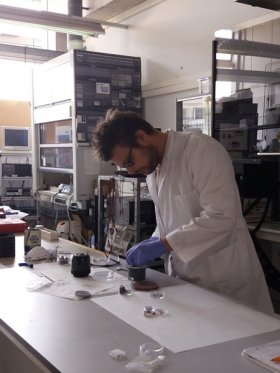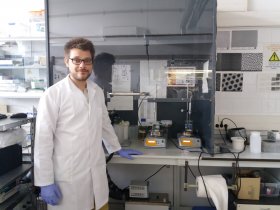Jakub Domagalski


PhD Programme: Technologies for Nanosystems, Bioengineering and Energy
Research group: NEPHOSYS - Nanoelectronic and Photonic Systems
Supervisors: Lluís Marsal Garví & Elisabet Xifré Pérez
Bio
Jakub Tomasz Domagalski holds MSc degree from Technical University Of Lodz, Poland in Nanotechnology (2011-2016). During this period, he participated in R&D project at University Twente, MESA+ Institute (Netherlands) where he was working on development of single-chain polymer nanoparticles. After defending his thesis, he undertook researcher internship at Unilever R&D department for 3 months, working on optimalization of core formulae for liquid food products.
Project: Electrochemically engineered anodic alumina Nanotubes: physico-chemical properties and Applications
Most of the time since its discovery, nanoporous anodic alumina was used as a protective coating. The intrinsic property revealed by the electron microscope - porosity - encouraged researchers to investigate new methods of porous alumina fabrication, obtaining complex geometries with various properties. In this thesis, anodic alumina nanotubes (AANTs) are developed through a carefully adjusted anodization process defined as pulse anodization. The process consists of interlacing current pulses of low (~6 mA/cm2) and high (~290-390 mA/cm2) density. Sufficiently high current flow affects the formation of the structure, resulting in vertical pore narrowings and weaker cell junctions. Selective acid etching and sonication in water enables to yield colloids of nanotubes. First aim of this thesis is a thorough analysis of the process to better understand the formation mechanism of AANTs and precisely connect anodization conditions with the resultant geometry of the structure. Second goal is to evaluate and optimize post-processing investigating further possibilities to alter physio-chemical properties of AANTs. Last objective is to design and fabricate functional nanotubes and propose their applications. This work reports the evolution of the anodization profile depending on the process conditions. Further, current and potential of the process are associated with the geometry and the properties of the obtained nanotubes: length, inner and outer diameter, z-potential and size dispersity. In brief, higher current leads to longer and narrower nanotubes with lower surface charge. Sonication conditions are evaluated leading to the proposal of a more optimal set of parameters. Annealing of the nanotubes is demonstrated to impact on their crystalline structure and elemental composition: temperature increase leads to higher crystalline fraction and decrease their sulfur content. Nanotubes are later electrostatically-decorated with maghemite nanoparticles and modified inside with a fluorophore labelled protein. These magnetically responsive colloids demonstrate stimuli-responsive detection of cathepsin B, supporting its utility as a sensor.
Open Access publications
- Domagalski, Jakub T., Elisabet Xifre-Perez, and Lluis F. Marsal. 2021. "Recent Advances in Nanoporous Anodic Alumina: Principles, Engineering, and Applications" Nanomaterials 11, no. 2: 430. View full-text
- PHD THESIS: Electrochemically engineered anodic alumina Nanotubes: physico-chemical properties and Applications
Outreach activities
- European Researchers' Night 2019: “El grafè: un material meravellós”.
- European Researchers’ Night 2020: “The solar revolution”.
International secondment
- University of Adelaide, Australia. 3 months (2020).



